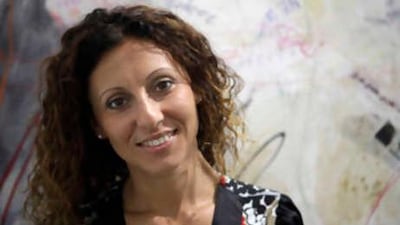As an artist, I don't have a fixed income. I spend what I have and as I need it. When money comes in, I have to budget it throughout the year, so I am very careful. I live for my art. It's what makes my life possible and, therefore, it comes before everything. When I think of where to spend my money, investing in my work will always take priority.
I grew up in Sermoneta, Italy, which is a hill town and commune in the province of Latina. There wasn't that much to do and there weren't many other children to play with. As a girl, I spent most of my time just drawing. That was how I entertained myself. As a child, if I wanted money I worked for it. My first job was in a pizzeria when I was 14. I had to take care of my own finances because my family couldn't really afford to dispense allowances for my sister, brother and I. I worked in restaurants throughout my teenage years.
When I was 17, I sold my first work, which was an abstract painting for an acquaintance who wanted it for her office. I later studied at the fine arts academy in Rome. I would later teach there for two years from 2008 to 2009, but sadly, the financial crisis in Italy led to large job cuts and I could no longer continue there. My salary back then was ?1,300 (Dh6,030) a month. In January, I moved to Doha, where my partner works as a designer, and I spend the rest of my time in Italy. I'd say that I'm in Doha for seven to eight months of the year. Back in Italy, I have my art studio and I own a small gallery as well. Both are located in Latina, which is 50km from Rome.
I don't have an agent and I promote my art by myself. I sell a lot of my work in Italy, but I also have a modest foreign presence. I had my first exhibition outside of Europe in Las Vegas in August 2007 at a venue called The Magic Marketplace. That went quite well and it offered excellent exposure for not just my art, but also my brand and design company, Laranarossa, which means "red frog". With this brand, I use my art to decorate various day-to-day items and accessories such as bags and jewellery, for example.
I co-own this venture with my partner. We started the company in 2003, but we only registered the trademark in 2009. Part of the income I make from Laranarossa is used to manage my day-to-day expenses and another part is put back into my art and travelling. This trip to Dubai, for example, was financed through the design company. I am in Dubai to launch and promote my latest exhibition. It's my first time in the UAE. The exhibition features several of my works, which are currently on display at The Mojo Gallery in Dubai, located in the Al Quoz area. It started on July 7 and will run for a month.
My art is largely about what I live. It represents the emotions and experiences in my life. The work I have exhibited in Dubai is influenced by Arab culture, which I have been exposed to for the first time while living in Doha. Art is a major investment in more ways than one. When I start, the process of painting is more immediate. Then, afterwards, I slow myself down a bit, step back and let things sink in more. I would say it takes three or four days to complete one piece.
Meanwhile, art materials in general are expensive. In the UAE, some things are actually more expensive than in Europe, which is too bad. Colours, or paint, are more or less the same price. But brushes and primers are a bit more. If I want to frame my work, that is at least four times more expensive than back home. I have on occasion printed pictures onto canvas to then use that as a base for my painting. This is quite an investment on my part, as printing images on canvas can cost up to ?100 to ?150 per square metre. In a canvas over two square metres, you're looking at ?300 just for the print alone. These days, unless there is a specific gallery commissioning such a type of work and financing me, I won't use that option. For an average painting, material wise, I'd say it costs me around ?400.
I follow a specific co-efficient for the sale of art, which was advised to me by a renowned Italian curator and art critic named Andrea Bellini, who is the director of the Artissima fair in Turin. He oversaw one of my first exhibitions in 2001. At the time, he taught me how to calculate and price my work. Each artist is advised a certain co-efficient depending on their age, exposure in media, exhibitions and what awards they have achieved. The more achievements an artist has, the bigger the co-efficient and the more expensive the paintings will be.
I'm now 36 years old and my dream is to one day have a very beautiful, spacious studio and gallery. In the meantime, I try to live by my father's advice. He told me to always be honest with myself and others and be happy, even if things don't exactly go how you want. He would always seem happy - even when things were hard. * As told to Jeffrey Todd

